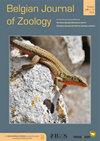Assessing trophic relationships between shallow-water black corals (Antipatharia) and their symbionts using stable isotopes
IF 1.3
4区 生物学
Q2 ZOOLOGY
引用次数: 9
Abstract
Shallow-water antipatharians host many symbiotic species, which spend their adult life with their host and/or use them to have access to food. Here we determine the trophic relationships between four common macrosymbionts observed on/in Cirripathes anguina , Cirrhipathes densiflora and Stichopathes maldivensis in SW Madagascar. These include the myzostomid Eenymeenymyzostoma nigrocorallium , the gobiid fish Bryaninops yongei , and two palaemonid shrimps, Pontonides unciger and Periclimenes sp. The first is an endosymbiont living in the digestive tract, while the others are ectosymbionts. The analyses show that most likely (i) none of the symbionts uses the host as a main food source, (ii) nocturnal plankton represents a main part of the diet of antipatharians while the symbionts feed preferentially on diurnal plankton, (iii) the myzostomid has the narrowest trophic niche, (iv) the two shrimps have distinct trophic niches and feed at lower trophic level than do the other symbionts. Concerning the myzostomids, they had the same δ13C values but had significantly higher δ15N values than the hosts. TEFs (Trophic Enrichment Factors) recorded were Δ13C = 0.28 ± 0.25 ‰ and Δ15N = 0.51 ± 0.37 ‰, but these were not high enough to explain a predator-prey relationship. These worms rely on the coral diet but may also ingest host fluids explaining the slight enrichment in heavier nitrogen isotopes. On the other hand, the ectosymbionts use the coral as a pathway to have access to food from the midwater: they feed from the water passing nearby the black corals, but a kleptoparasitic behaviour cannot be excluded.利用稳定同位素评估浅水黑珊瑚(Antipatharia)及其共生体之间的营养关系
浅水反蛛类拥有许多共生物种,这些物种成年后与宿主一起生活和/或利用宿主获得食物。在这里,我们确定了在马达加斯加西南部的血圆藻、密圆藻和马尔迪夫Stichopathes maldivensis上观察到的四种常见巨型共生体之间的营养关系。其中包括myzostomid Eeymeenymyzotoma nigrocollarium、虾虎鱼Bryaninops yongei,以及两种palaemonid虾Pontonides unciger和Periclimenes sp.。第一种是生活在消化道中的内共生体,而其他是外共生体。分析表明,最有可能的是(i)没有一种共生体将宿主作为主要食物来源,(ii)夜间浮游生物是反蛛类食物的主要组成部分,而共生体优先以日间浮游生物为食,(iii)myzostomid的营养生态位最窄,(iv)与其他共生体相比,这两种虾具有不同的营养生态位,以较低的营养水平为食。关于myzostomid,它们具有相同的δ13C值,但具有显著高于宿主的δ15N值。记录的营养富集因子为Δ13C = 0.28 ± 0.25‰和Δ15N = 0.51 ± 0.37‰,但这还不足以解释捕食关系。这些蠕虫依赖珊瑚饮食,但也可能摄入宿主流体,这解释了较重氮同位素的轻微富集。另一方面,外共生体利用珊瑚作为从中层水域获取食物的途径:它们从黑珊瑚附近经过的水中觅食,但不能排除窃盗寄生行为。
本文章由计算机程序翻译,如有差异,请以英文原文为准。
求助全文
约1分钟内获得全文
求助全文
来源期刊

Belgian Journal of Zoology
生物-动物学
CiteScore
1.90
自引率
0.00%
发文量
10
审稿时长
>12 weeks
期刊介绍:
The Belgian Journal of Zoology is an open access journal publishing high-quality research papers in English that are original, of broad interest and hypothesis-driven. Manuscripts on all aspects of zoology are considered, including anatomy, behaviour, developmental biology, ecology, evolution, genetics, genomics and physiology. Manuscripts on veterinary topics are outside of the journal’s scope. The Belgian Journal of Zoology also welcomes reviews, especially from complex or poorly understood research fields in zoology. The Belgian Journal of Zoology does no longer publish purely taxonomic papers. Surveys and reports on novel or invasive animal species for Belgium are considered only if sufficient new biological or biogeographic information is included.
 求助内容:
求助内容: 应助结果提醒方式:
应助结果提醒方式:


